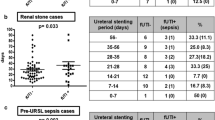Abstract
Objective
We aimed to assess the impact of the timing of urinary drainage on clinical outcomes in patients with obstructive pyelonephritis (OPN) associated with upper urinary tract (UUT) stones.
Methods
We retrospectively evaluated the multicenter dataset of 240 patients with OPN associated with UUT stones who underwent urinary drainage. We divided the patients into two groups depending on the timing of urinary drainage; emergency drainage, defined as within 12 h from admission, and delayed drainage, defined as between 12 and 48 h from admission. The outcomes were the length of hospital stay, time to leukocyte normalization, and time to body temperature normalization. One-to-two propensity score matching (PSM) was applied to minimize the effect of confounders between the two groups. Subsequently, predictive patient factors for emergency drainage were analyzed using the logistic regression model.
Results
Only the time from admission to normal body temperature was significantly shorter in the emergency drainage group when compared with the delayed drainage group (median: 2 vs. 3 days; p = 0.02), while there was no difference in time from drainage to body temperature normalization between the two groups. On multivariable analysis, high pretreatment C-reactive protein (CRP) was associated with implementing emergency drainage within 12 h.
Conclusions
The timing of urinary drainage was only associated with the duration of high fever, but it did not affect the postdrainage course. Emergency urinary drainage is more likely to be performed in severe patients, such as high pretreatment CRP.
Similar content being viewed by others
Data availability
The data that support the findings of this study are available on request from the corresponding author upon reasonable request.
Abbreviations
- OPN:
-
Obstructive pyelonephritis
- UUT:
-
Upper urinary tract
References
Hsu CY, Fang HC, Chou KJ, Chen CL, Lee PT, Chung HM (2006) The clinical impact of bacteremia in complicated acute pyelonephritis. Am J Med Sci 332:175–180. https://doi.org/10.1097/00000441-200610000-00004
Yoshimura K, Utsunomiya N, Ichioka K, Ueda N, Matsui Y, Terai A (2005) Emergency drainage for urosepsis associated with upper urinary tract calculi. J Urol 173:458–462. https://doi.org/10.1097/01.JU.0000150512.40102.BB
Borofsky MS, Walter D, Shah O, Goldfarb DS, Mues AC, Makarov D V. (2013) Surgical decompression is associated with decreased mortality in patients with sepsis and ureteral calculi. Journal of Urology 189:. https://doi.org/10.1016/j.juro.2012.09.088
Haas CR, Li G, Hyams ES, Shah O (2020) Delayed Decompression of Obstructing Stones with Urinary Tract Infection is Associated with Increased Odds of Death. J Urol 204:. https://doi.org/10.1097/JU.0000000000001182
Haas CR, Smigelski M, Sebesta EM, Mobley D, Shah O (2021) Implementation of a Hospital-Wide Protocol Reduces Time to Decompression and Length of Stay in Patients with Stone-Related Obstructive Pyelonephritis with Sepsis. J Endourol 35:. https://doi.org/10.1089/end.2020.0626
Kamei J, Sugihara T, Yasunaga H, Matsui H, Sasabuchi Y, Fujimura T, Homma Y, Kume H (2023) Impact of early ureteral drainage on mortality in obstructive pyelonephritis with urolithiasis: an analysis of the Japanese National Database. World J Urol. https://doi.org/10.1007/s00345-023-04375-2
Blackwell RH, Barton GJ, Kothari AN, Zapf MAC, Flanigan RC, Kuo PC, Gupta GN (2016) Early Intervention during Acute Stone Admissions: Revealing “The Weekend Effect” in Urological Practice HHS Public Access. J Urol 196:124–130. https://doi.org/10.1016/j.juro.2016.01.056
Srougi V, Moscardi PR, Marchini GS, Berjeaut RH, Torricelli FC, Mesquita JLB, Srougi M, Mazzucchi E (2018) Septic Shock Following Surgical Decompression of Obstructing Ureteral Stones: A Prospective Analysis. J Endourol 32:446–450. https://doi.org/10.1089/END.2017.0896
Angulo JC, Gaspar MJ, Rodríguez N, García-Tello A, Torres G, Núñez C (2010) The value of C-reactive protein determination in patients with renal colic to decide urgent urinary diversion. Urology 76:301–306. https://doi.org/10.1016/j.urology.2009.12.002
Tambo M, Okegawa T, Shishido T, Higashihara E, Nutahara K Predictors of septic shock in obstructive acute pyelonephritis. https://doi.org/10.1007/s00345-013-1166-4
Holena DN, Hadler R, Wirtalla C, Carr B, Morris JB, Kelz RR (2011) Teaching status: The impact on emergency and elective surgical care in the US. Ann Surg 253:1017–1023. https://doi.org/10.1097/SLA.0B013E3182171FD1
Lapointe-Shaw L, Abushomar H, Chen XK, Gapanenko K, Taylor C, Krzyzanowska MK, Bell CM (2016) Care and outcomes of patients with cancer admitted to the hospital on weekends and holidays: a retrospective cohort study. J Natl Compr Canc Netw 14:867–874. https://doi.org/10.6004/JNCCN.2016.0091
Tambo M, Taguchi S, Nakamura Y, Okegawa T, Fukuhara H (2020) Presepsin and procalcitonin as predictors of sepsis based on the new Sepsis-3 definitions in obstructive acute pyelonephritis. BMC Urol 20:. https://doi.org/10.1186/s12894-020-00596-4
Acknowledgements
None.
Funding
NA (no external funding provided).
Author information
Authors and Affiliations
Contributions
SK and TY (Takafumi Yanagisawa) contributed to protocol/project development, data collection and management, data analysis, and manuscript writing/editing. YY, KM, SH, KI, TS, YI, MM, KH, and TY (Toshihiro Yamamoto) contributed to data collection. TK contributed to manuscript editing and supervision.
Corresponding author
Ethics declarations
Conflicts of Interest
Takahiro Kimura is a paid consultant/advisor of Astellas, Bayer, Janssen and Sanofi. The other authors declare no conflicts of interest associated with this manuscript.
Additional information
Publisher's Note
Springer Nature remains neutral with regard to jurisdictional claims in published maps and institutional affiliations.
Supplementary Information
Below is the link to the electronic supplementary material.
Rights and permissions
Springer Nature or its licensor (e.g. a society or other partner) holds exclusive rights to this article under a publishing agreement with the author(s) or other rightsholder(s); author self-archiving of the accepted manuscript version of this article is solely governed by the terms of such publishing agreement and applicable law.
About this article
Cite this article
Kayano, S., Yanagisawa, T., Yata, Y. et al. Impact of timing of urinary drainage on clinical outcomes in patients with obstructive pyelonephritis associated with upper urinary tract stones: a propensity score-matched analysis. World J Urol 42, 147 (2024). https://doi.org/10.1007/s00345-024-04871-z
Received:
Accepted:
Published:
DOI: https://doi.org/10.1007/s00345-024-04871-z



